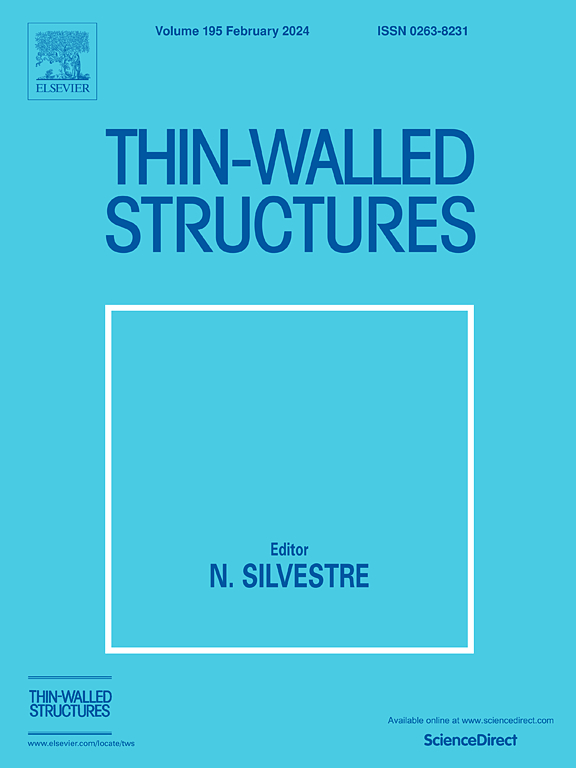带阶梯面片的爆炸加载 FGM 夹层板的自由振动和非线性瞬态分析:分析和人工神经网络方法
IF 5.7
1区 工程技术
Q1 ENGINEERING, CIVIL
引用次数: 0
摘要
本研究探讨了由粘弹性地基支撑的功能分级材料(FGM)阶梯面夹层板(FGM-SPSFS)在爆炸荷载作用下的自由振动和瞬态动态响应。研究重点是几何配置和材料特性变化对各部分的影响。每块板由三层组成:一层均匀的硬芯和两层 FGM 面板,水平分为两段,面板厚度不同,在保持总厚度一致的同时增强了结构刚度。夹层板的材料特性遵循幂律分布。计算公式基于高阶剪切变形板理论和 von Kármán 几何非线性,并使用 Galerkin 方法求解。通过将结果与已发表的文献和有限元分析(FEA)进行比较,实现了验证。利用 MATLAB 中的贝叶斯正则化 (BR) 和 Levenberg-Marquardt (LM) 算法开发了人工神经网络 (ANN) 模型,无需大量计算即可预测自然频率。新的图形用户界面 (GUI) 工具有助于使用拟议的 ANN 模型进行频率预测。主要研究结果表明,对阶梯面片和芯层的修改会影响刚度、固有频率和振幅。增加芯层与总厚度的比率可提高刚度,从而提高频率并降低位移振幅。LM 算法优于 BR 算法,误差一般低于 1%,而使用对数-sigmoid 函数的 BR 算法误差为 2% 至 4%。这项研究为工程应用中的 FGM 夹层结构设计和分析提供了宝贵的见解。本文章由计算机程序翻译,如有差异,请以英文原文为准。
Free vibration and nonlinear transient analysis of blast-loaded FGM sandwich plates with stepped face sheets: Analytical and artificial neural network approaches
This study investigates the free vibration and transient dynamic response of functionally graded material (FGM) sandwich plates with stepped face sheets (FGM-SPSFS) supported by viscoelastic foundation under blast loading. The research focuses on the effects of geometric configurations and material property variations across segments. Each plate comprises three layers: a homogeneous hard core and two FGM face sheets, divided horizontally into two segments with differing face sheet thicknesses, which enhance structural stiffness while maintaining a consistent total thickness. The material properties of the sandwich plates follow a power-law distribution. The formulations are based on higher-order shear deformation plate theory and von Kármán geometric nonlinearity, and are solved using Galerkin’s method. Validation is achieved by comparing the results with published literature and finite element analysis (FEA). Artificial neural network (ANN) models are developed to predict natural frequencies without extensive computational runs, employing Bayesian Regularization (BR) and Levenberg–Marquardt (LM) algorithms in MATLAB. A new graphical user interface (GUI) tool facilitates frequency predictions using the proposed ANN model. Key findings indicate that modifications to the stepped face sheets and core layers affect stiffness, natural frequency, and vibration amplitudes. Increasing the core-to-total thickness ratio enhances stiffness, resulting in higher frequencies and reduced displacement amplitudes. The LM algorithm outperforms the BR algorithm, with errors generally below 1%, compared to 2% to 4% for BR with the log-sigmoid function. This study offers valuable insights into the design and analysis of FGM sandwich structures for engineering applications.
求助全文
通过发布文献求助,成功后即可免费获取论文全文。
去求助
来源期刊

Thin-Walled Structures
工程技术-工程:土木
CiteScore
9.60
自引率
20.30%
发文量
801
审稿时长
66 days
期刊介绍:
Thin-walled structures comprises an important and growing proportion of engineering construction with areas of application becoming increasingly diverse, ranging from aircraft, bridges, ships and oil rigs to storage vessels, industrial buildings and warehouses.
Many factors, including cost and weight economy, new materials and processes and the growth of powerful methods of analysis have contributed to this growth, and led to the need for a journal which concentrates specifically on structures in which problems arise due to the thinness of the walls. This field includes cold– formed sections, plate and shell structures, reinforced plastics structures and aluminium structures, and is of importance in many branches of engineering.
The primary criterion for consideration of papers in Thin–Walled Structures is that they must be concerned with thin–walled structures or the basic problems inherent in thin–walled structures. Provided this criterion is satisfied no restriction is placed on the type of construction, material or field of application. Papers on theory, experiment, design, etc., are published and it is expected that many papers will contain aspects of all three.
 求助内容:
求助内容: 应助结果提醒方式:
应助结果提醒方式:


